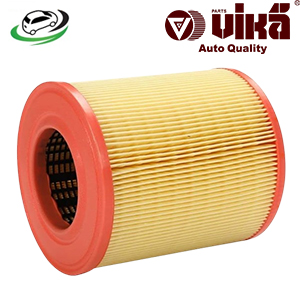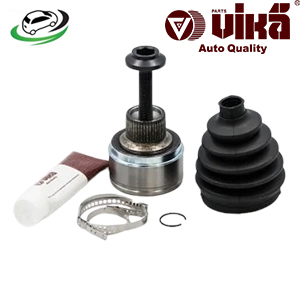-21%
Get CV Joint & Boot Kit Front Outer AUDI A4 Quattro/A5 Quattro/Q5 Allroad 8R0498099
The Constant Velocity (CV) joint and boot kit is an essential component in the drivetrain of front-wheel drive, all-wheel drive, and some rear-wheel drive vehicles. The CV joint ensures smooth power transfer from the transmission to the wheels, allowing for the necessary flexibility during steering and suspension movement. The boot is designed to protect the CV joint from contaminants. Here’s an in-depth exploration of the construction, function, benefits, common issues, signs of failure, and maintenance of a CV joint and boot kit.
Construction and Function of a CV Joint & Boot Kit
Construction:
- CV Joint:
- Types:
- Rzeppa Joint: This is the most common type of CV joint, featuring an inner and outer race with six steel balls in between. It allows for a wide range of motion and is typically found on the outer part of the driveshaft.
- Tripod Joint: Found on the inner side of the driveshaft, this joint consists of three roller bearings mounted on a tripod, allowing for axial and angular movement.
- Materials: Typically made from high-strength steel to withstand the high stresses and rotational forces.
- Types:
- Boot:
- Material: Usually made from rubber or thermoplastic elastomer, chosen for flexibility and resistance to temperature changes.
- Design: A conical shape that fits snugly over the CV joint, with clamps or bands at either end to secure it to the driveshaft and joint.
- Grease:
- Lubrication: The CV joint is packed with high-temperature grease to reduce friction and wear.
- Sealing: The boot keeps the grease in and contaminants out.
Function:
- Power Transfer:
- Smooth Operation: The CV joint allows for the transfer of rotational force from the transmission to the wheels, even when the driveshaft is at an angle.
- Flexibility: Accommodates the up and down movement of the suspension and the steering angles of the front wheels.
- Protection:
- Contaminant Exclusion: The boot prevents dirt, water, and other contaminants from entering the CV joint.
- Grease Retention: Keeps the grease inside the joint, ensuring proper lubrication.
Benefits of a CV Joint & Boot Kit
- Smooth Power Delivery:
- Constant Velocity: Provides a smooth and constant transfer of power to the wheels, regardless of the angle of the driveshaft.
- Enhanced Driving Experience: Reduces vibrations and ensures smooth acceleration and turning.
- Durability:
- High-Strength Materials: Made from durable materials to withstand the stresses of driving, including high speeds and rough terrain.
- Long Service Life: With proper maintenance, CV joints can last a long time, providing reliable performance.
- Protection:
- Boot Function: The boot protects the CV joint from contaminants and retains grease, which is crucial for the longevity of the joint.
- Cost-Effective: Replacing the boot when it shows signs of wear can prevent expensive damage to the CV joint.
- Performance:
- Handling: Ensures that the vehicle handles well, with responsive steering and stable suspension.
- Efficiency: Properly functioning CV joints contribute to the overall efficiency of the drivetrain.
Common Issues with CV Joints & Boots
- Boot Damage:
- Tears and Cracks: The boot can tear or crack over time due to exposure to road debris, temperature changes, and aging.
- Contaminant Ingress: A damaged boot allows dirt and moisture to enter the joint, leading to accelerated wear and potential failure.
- Grease Leakage:
- Boot Failure: If the boot fails, grease can leak out, leaving the CV joint inadequately lubricated.
- Joint Wear: Lack of lubrication leads to increased friction and wear, causing the joint to fail.
- Joint Wear:
- Noise: Worn CV joints often produce a clicking or popping noise, especially during sharp turns.
- Vibration: A failing CV joint can cause vibrations that are felt through the steering wheel or the vehicle’s floor.
- Corrosion:
- Exposure: If contaminants enter the joint, corrosion can occur, further weakening the components.
- Water Ingress: Moisture can cause rust, which degrades the metal parts of the CV joint.
Signs of Failing CV Joints & Boots
- Noise:
- Clicking or Popping: A distinctive clicking or popping sound when turning, especially during acceleration, indicates a worn outer CV joint.
- Clunking: A clunking noise when shifting from drive to reverse can suggest inner CV joint issues.
- Vibrations:
- Steering Wheel: Vibrations felt through the steering wheel during acceleration can indicate CV joint problems.
- Vehicle Floor: Vibrations through the vehicle floor can also be a sign of a failing CV joint.
- Grease Leakage:
- Visible Grease: Grease splattered around the inside of the wheel or along the underside of the vehicle suggests a torn boot.
- Dry Joint: A dry or exposed joint indicates a compromised boot.
- Handling Issues:
- Steering: Difficulty in steering or increased resistance when turning can indicate CV joint issues.
- Suspension: Increased body roll or instability during turns can be related to CV joint problems.
Maintenance and Replacement of CV Joints & Boots
- Regular Inspections:
- Visual Checks: Regularly inspect the CV boots for cracks, tears, or signs of wear.
- Listen for Noises: Pay attention to any unusual noises during driving, particularly when turning.
- Timely Replacement:
- Boot Replacement: Replace the boot as soon as it shows signs of damage to prevent contaminants from entering the joint.
- Joint Replacement: If the CV joint is worn or damaged, it should be replaced promptly to avoid further damage to the drivetrain.
- Proper Installation:
- Professional Service: Have CV joints and boots replaced by a professional to ensure proper installation and alignment.
- Use Quality Parts: Use high-quality replacement parts to ensure durability and performance.
- Lubrication:
- Proper Grease: Ensure the CV joint is packed with the correct type and amount of grease.
- Sealing: Make sure the boot is properly sealed to retain grease and exclude contaminants.
- Drive Carefully:
- Avoid Debris: Try to avoid driving over road debris that can damage the boots.
- Smooth Driving: Avoid harsh acceleration and sharp turns, which can stress the CV joints.
Follow us on Facebook for more parts.



